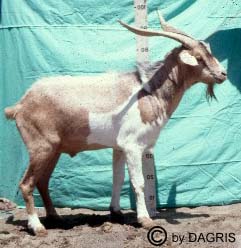
zurück zur Hauptseite / back to the main page
Ziege ABERGELLE Goat

|
Ziege |
ABERGELLE |
Goat |
|
Rassenursprung Domestizierte Ziegen mit leicht gedrehten Hörnern stammen von der Bezoarziege (Capra hircus aegargus) aus Südwest- Asien ab, wo die wilde Form noch besteht. Die Zeit der Domestikation war noch 7000 v. Ch.am Rande des heutigen Irans und Iraks. Bis zum 5. Jahrtausend hatten die Ziegen Ägypten erreicht. Der allgemeine kleine, kurzohrige und säbelförmig gehörnte Typ wurde schon in den Grabanstrichen des 4. Jahrtausends veranschaulicht. Es scheint, dass diese Arten der Ziegen stufenweise in Ägypten durch Ziegen mit Spiral- oder Korkenzieherhornen ersetzt wurden, welche ursprünglich vom Osten um 3500 v. Ch. nach Ägypten gebracht wurden. Die kurzohrigen und kurzhornigen Ziegen behaupteten jedenfalls ihre Stellung im äquatorialen Westen,Zentral – und Ostafrika. Im humiden und heissem Klima von West- und Zentralafrika neigen die heutigen Ziegen dieses Typs zur Zwergwüchsigkeit, es besteht die Annahme, eine natürliche Auslese der Thermoregolation unter dem ungemütlichen humiden und heissen Klimas zu sein. Zusätzlich hat die westafrikanische zwergartige Ziege häufig die kurzen gebeugten Beine, die der Achondroplasie zugeschrieben werden. Es ist möglich dass dieses charakteristische Merkmal durch die Züchter wegen ihrer Seltenheit ausgelesen wurde. Die Merkmale dieses Ziegentyps bestehen südwärts durch Zentralafrika bis nach Zaire, Angola und dem Norden Namibias. (Mason, 1984). |
Group Origin Domestic goats with scimitar-like horns are considered to have descended from the Bezoar goat (Capra hircus aegargus) in south-west Asia, where the wild form still exists. The time of domestication was before 7000 BC around the borders of the present-day Iran and Iraq. Goats had reached Egypt by the 5th millennium BC and the small short-eared, sabre-horned, generalized type was occasionally illustrated on the tomb paintings of the 4th millennium. It appears that as these types of goats were gradually replaced in Egypt by goats with spiral or corkscrew horns, which had originally entered Egypt from the east about 3500 BC. However, the short-eared and short-horned goats maintained their presence in the equatorial west, central and east Africa. In humid and hot climate of west and central Africa, the present-day goats of this type tend to be dwarf, which is believed to be due to natural selection on thermoregulation under the unfavourable humid and hot climate. In addition the West African Dwarf goat often has short bowed legs attributed to achondroplasia. It is possible that this characteristic was deliberately selected for by owners just for its oddness. The distribution of this goat type extends southwards through central Africa as far as Zaire, Angola and the north of Namibia (Mason, 1984). |
|
Hauptvorkommen Versorgt von den ethnischen Völkern Agew und Tigray im Norden Äthiopias, aber ihre Verteilung reicht den Tekeze Fluss in der Provinz des südlichen Tigray (Tembien und Inderta) , Nord Wollo (Wag und Raya-Azabo) und Ost Gonder entlang; die Wirtschaftssysteme sind gemischt, auch gibt es landwirtschaftliche Beweidung (Semien, FARM-Africa, 1996) |
Main Location Maintained by the Agew and Tigray ethnic groups of northern Ethiopia, but their distribution is localised along the Tekeze river in the provinces of Southern Tigray (Tembien and Inderta), North Wollo (Wag and Raya-Azabo) and eastern Gonder; the production systems are mixed as well as agro-pastoral (FARM-Africa, 1996) |
|
Spezielle Eigenschaften Mittlere Grösse (65-75 cm), aber kräftig (28-34 kg); meist rötlich braune Farbe, männliche Tiere haben prächtige Spiralhörner; das Haar ist kurz und weich, alle männlichen Tiere haben einen Halskragen und Bärte (94%) (FARM-Africa, 1996).
|
Special Characteristics Medium size (65-75cm height) but stocky (28–34 kg); mostly reddish brown in colour; males have magnificient spiral horns; the hair is short and smooth; all males have ruffs, and beards (94%) (FARM-Africa, 1996). |
|
Subgroup Information Ethiopian Rift Valley Family
|
Subgroup Information Ethiopian Rift Valley Family |
zurück zur Hauptseite / back to the main page
Forschungsstation für Ziegen und Zwergziegen
Administration: administration@ziegen-zwergziegen.ch
© Copyright: alle Daten und Bilder auf diesen Seiten sind urheberrechtlich geschützt.
© 2003 by Marianne Brunner, Pro Litteris CH-Zürich